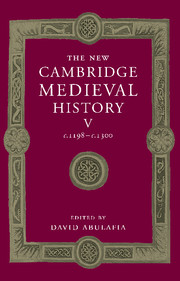Book contents
- Frontmatter
- Introduction
- Part I Common Themes
- Part II The Church in the Thirteenth Century
- 5 The papacy
- 6 The Albigensian Crusade and heresy
- 7 The Church and the laity
- 8 The Church and the Jews
- 9 The religious Orders
- 10 The universities and scholasticism
- Part III The Western Kingdoms
- Part IV Italy
- Part V The Mediterranean Frontiers
- Part VI The Northern and Eastern Frontiers
- Appendix Genealogical tables
- Primary sources and secondary works arranged by chapter
- Index
- Plate section
- Map 1 Europe in the thirteenth century
- Map 3 France, c. 1260
- Map 5 Germany and the western empire
- Map 6 Genoa, Venice and the Mediterranean
- Map 8 The Latin empire of Constantinople and its neighbours
- Map 10 Aragon and Anjouin the Mediterranean">
- References
5 - The papacy
from Part II - The Church in the Thirteenth Century
Published online by Cambridge University Press: 28 March 2008
- Frontmatter
- Introduction
- Part I Common Themes
- Part II The Church in the Thirteenth Century
- 5 The papacy
- 6 The Albigensian Crusade and heresy
- 7 The Church and the laity
- 8 The Church and the Jews
- 9 The religious Orders
- 10 The universities and scholasticism
- Part III The Western Kingdoms
- Part IV Italy
- Part V The Mediterranean Frontiers
- Part VI The Northern and Eastern Frontiers
- Appendix Genealogical tables
- Primary sources and secondary works arranged by chapter
- Index
- Plate section
- Map 1 Europe in the thirteenth century
- Map 3 France, c. 1260
- Map 5 Germany and the western empire
- Map 6 Genoa, Venice and the Mediterranean
- Map 8 The Latin empire of Constantinople and its neighbours
- Map 10 Aragon and Anjouin the Mediterranean">
- References
Summary
THE thirteenth century holds a significant place in the history of papal monarchy. This period saw the papacy reach the peak of the effectiveness towards which it had been moving throughout the twelfth century. However, it also saw the beginnings of the decline of that effectiveness, which was to gather momentum in the later Middle Ages.
The papacy was a unique sort of monarchy in that it claimed jurisdiction in both spiritual and temporal affairs. It claimed primacy of jurisdiction as ‘monarch of all Churches’, headship of the ecclesiastical world. It did not claim a comparable jurisdiction over the secular world because it did not doubt that a division of spiritual and temporal powers had been decreed by God himself. But it did claim a right to judge lay rulers and, at its own assessment of need, otherwise to intervene authoritatively in the temporal order. In addition to these two types of jurisdiction, spiritual and temporal, it laid claim to a third: over a state of its own. By virtue of the Patrimony of St Peter, it possessed in its own right territorial jurisdiction over a central Italian state, wherein the pope ruled like any other European monarch.
During the thirteenth century, each of these three types of papal jurisdiction underwent important change. In the opening decades of the century, especially in the pontificates of Innocent III (1198–1216), Honorius III (1216–27) and Gregory IX (1227–41), the papacy either initiated, or very quickly associated itself with, the new religious and intellectual movements of the age. Papal government extended its range and improved its quality to an extent unprecedented in earlier papal history. In the political sphere, similarly, it was involved more deeply and widely than previously. It sought to expand and effectively to control the Papal State with a vigour which was new.
- Type
- Chapter
- Information
- The New Cambridge Medieval History , pp. 105 - 163Publisher: Cambridge University PressPrint publication year: 1999
References
- 1
- Cited by

